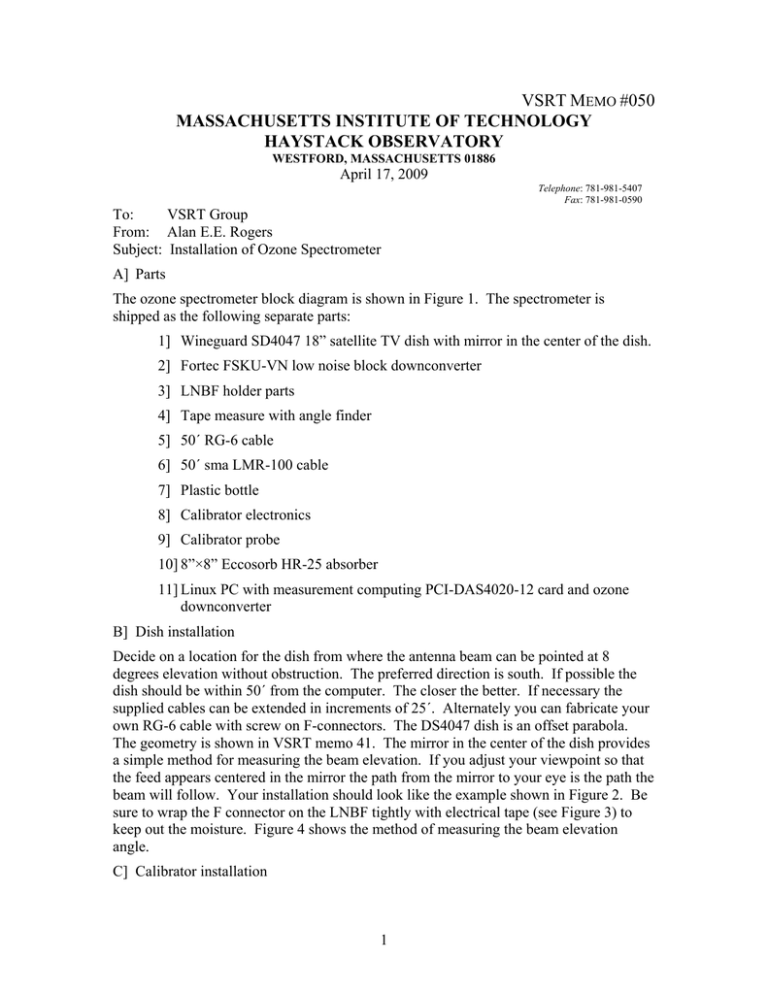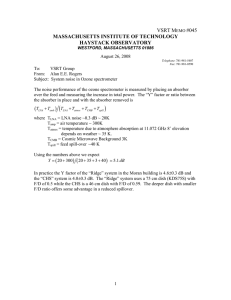VSRT M #050 MASSACHUSETTS INSTITUTE OF TECHNOLOGY
advertisement

VSRT MEMO #050 MASSACHUSETTS INSTITUTE OF TECHNOLOGY HAYSTACK OBSERVATORY WESTFORD, MASSACHUSETTS 01886 April 17, 2009 Telephone: 781-981-5407 Fax: 781-981-0590 To: VSRT Group From: Alan E.E. Rogers Subject: Installation of Ozone Spectrometer A] Parts The ozone spectrometer block diagram is shown in Figure 1. The spectrometer is shipped as the following separate parts: 1] Wineguard SD4047 18” satellite TV dish with mirror in the center of the dish. 2] Fortec FSKU-VN low noise block downconverter 3] LNBF holder parts 4] Tape measure with angle finder 5] 50΄ RG-6 cable 6] 50΄ sma LMR-100 cable 7] Plastic bottle 8] Calibrator electronics 9] Calibrator probe 10] 8”×8” Eccosorb HR-25 absorber 11] Linux PC with measurement computing PCI-DAS4020-12 card and ozone downconverter B] Dish installation Decide on a location for the dish from where the antenna beam can be pointed at 8 degrees elevation without obstruction. The preferred direction is south. If possible the dish should be within 50΄ from the computer. The closer the better. If necessary the supplied cables can be extended in increments of 25΄. Alternately you can fabricate your own RG-6 cable with screw on F-connectors. The DS4047 dish is an offset parabola. The geometry is shown in VSRT memo 41. The mirror in the center of the dish provides a simple method for measuring the beam elevation. If you adjust your viewpoint so that the feed appears centered in the mirror the path from the mirror to your eye is the path the beam will follow. Your installation should look like the example shown in Figure 2. Be sure to wrap the F connector on the LNBF tightly with electrical tape (see Figure 3) to keep out the moisture. Figure 4 shows the method of measuring the beam elevation angle. C] Calibrator installation 1 The frequency calibrator is needed to ensure the spectrometer will center the ozone line (11.0724545 GHz) in the spectrum. The calibrator is not water tight and needs to be protected from the elements with a plastic bottle. Use silicone sealer to ensure that water will not leak down the probe cable into the calibrator. The probe polarization should align with the LNBF. Figure 5 shows details of the calibrator installation. D] Computer and spectrometer installation The spectrometer downconverter is attached to the outside of the computer. When you set-up the computer the following connection will be needed as illustrated in Figure 6: 1] A.C. power to computer 2] A.C. power to spectrometer 3] RG-6 (F connector) to LNBF 4] SMA cable to calibrator 5] BNC from the spectrometer card 6] Digital I/O from spectrometer to DAS-4020 (this should also be in place) 7] Network RJ-45 needed to return data to Haystack 8] Keyboard, monitor and mouse Apply power and computer should start to boot as the CMOS BIOS was set to power-up upon restoration of power after a power failure. The computer will automatically return the ozone data to Haystack once per day. If a keyboard, mouse and monitor are attached the user can access the PC. The user name is ozone. If this is a new installation the user should contact Haystack for pass words and other details. The PC should be able to get data back to Haystack as long as the internet can be accessed from the network connection to the PC. The ozone spectrometer computer contacts Haystack every morning with the previous day’s data. It runs Linux 2.6. For security reasons, all ports will be closed except for 80 outgoing (to transmit the data via http). It is highly desirable to allow port 22 incoming (to allow ssh connections in order to patch the system as necessary). If not system patches will have to be made locally by attaching a keyboard, monitor and mouse. It is not necessary to provide the computer with a static IP address; DHCP is fine. This setup is intended to be as secure as possible while allowing the unit to transmit data back with minimal intervention (perhaps none at all, short of plugging the cables and turning it on) on your part. This should be discussed with your IT department both to let them know that a new computer will be appearing on their network and to identify any security concerns that they may have. E] Software running and available test software The ozone spectrometer real time program was loaded and checked at Haystack and should start running after the pc boots. The commands to load the PCI bus driver for the DAS-4020 and start the program are in /etc/rc.local. If necessary the program can be stopped by the kill command as root. For test purposes the program can be run manually with display 2 /home/vsrt/ozone/ozspec when started by rc.local the –nodisplay option is used. The ozspec program writes to an output file about every 70 seconds in the /home/vsrt/ozone/ directory. A new file is started each day with a name set by the year and day of year. These files can be processed locally using the program /home/vsrt/ozone/ozoneplot. F] Manual calibration of the spectrometer The system noise temperature is determined by the noise temperature of the LNBF plus the contribution from the atmosphere and the antenna spillover. The details are in VSRT memo #45. The LNBF has been measured at Haystack but we provide a piece of absorber for a local measurement. The calibration is performed by placing the absorber1 over the LNBF, as shown in figure 7, for a few spectrometer cycles (say 5 minutes) removing it for a few cycles and repeating the process for several absorber on/off cycles. The “Y-factor” is the power ratio between the absorber on and the absorber off. The Yfactor should be in the range between 4 and 5 dB. If the Y-factor will also be degraded in very poor weather or when the Sun is in the beam. The spectrometer power for each spectrum is in the output file and is listed when the file is processed by ozoneplot. G] Photos of the installation Photos of the installation from the following vantage points are useful: 1] From the front 2] From the side as a rough check on the pointing elevation – which presumably you set using the angle measuring level we sent with the dish. 3] In the direction, at the horizon, in which the dish is pointing so we can use google to check the azimuth of the pointing from other features which should show up in the satellite maps. 1 The denser side should be away from the feed. 3 Figure 1. 4 Figure 2. When correctly assembled the LNBF should be 13” (± 0.25”) from a point 9” up from the bottom edge of the reflector. The LNBF should point towards a point 9” from the bottom of the reflector rather than right at the center. The bottom edge of the front LNBF should be 10” (± 0.25”) from the bottom of the reflector. 5 Figure 3. The connector should point down towards the ground and should be well taped to be sure water doesn’t get into the connector or the attenuator to which it is attached. 6 Setting beam elevation of 8 degrees angle 98 deg bubble centered Observe the reflection of the feed in the mirror in the center of the dish Figure 4. 7 Figure 5a. When correctly assembled the end of the calibrator probe should be at an angle of 45˚ degrees. 8 10 dB dc passing attenuator to improve LNBF match Tip of the calibration probe is approximately 45 degrees to LNBF output connector Be sure to tape over connections to prevent water from entering connector Figure 5b. Detail of calibrator probe. 9 Figure 6. 10 Figure 7. 11


